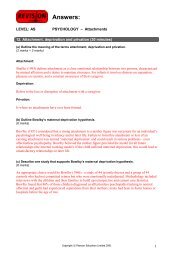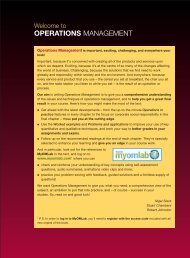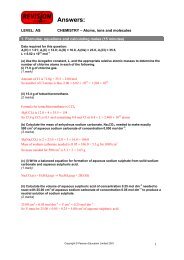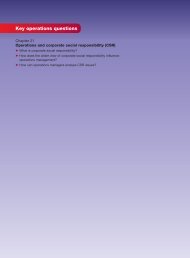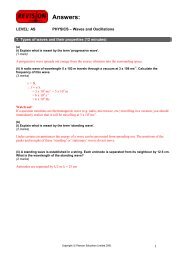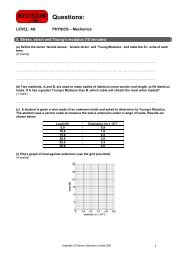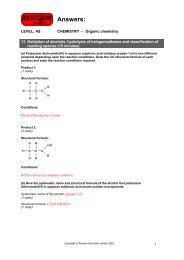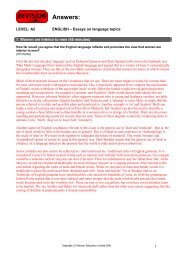10. Urban microclimate (25 minutes) - Pearson
10. Urban microclimate (25 minutes) - Pearson
10. Urban microclimate (25 minutes) - Pearson
Create successful ePaper yourself
Turn your PDF publications into a flip-book with our unique Google optimized e-Paper software.
Answers:<br />
LEVEL: AS<br />
GEOGRAPHY<br />
<strong>10.</strong> <strong>Urban</strong> <strong>microclimate</strong> (<strong>25</strong> <strong>minutes</strong>)<br />
Study the map below showing the distribution of minimum temperature over London during a<br />
night in May.<br />
(a)<br />
(i) What is the name give to lines linking places of equal temperatures?<br />
(1 mark)<br />
Isotherms (REMEMBER THERMS – THERMOMETERS).<br />
(ii) What name is given to the situation shown in the map?<br />
(1 mark)<br />
The urban heat island effect.<br />
(iii) What atmospheric conditions allow this pattern of temperatures to develop?<br />
(3 marks)<br />
Calm conditions, no wind (allows heat to build up).<br />
Hot, cloudless day (allows maximum insolation).<br />
Cloudless night skies (allow heat to escape).<br />
Copyright © <strong>Pearson</strong> Education Limited 2001 1
Answers:<br />
LEVEL: AS<br />
GEOGRAPHY<br />
(iv) In what ways does the built-up area contribute to the development of this temperature<br />
pattern?<br />
(5 marks)<br />
Heat absorbed by buildings and tarmac in the day is released at night.<br />
Many dark colours to absorb solar insolation.<br />
Domestic heating adds to natural heat release.<br />
(v) What effects do rivers and reservoirs have on the pattern of temperatures? Give an example<br />
to help your explanation.<br />
(2 marks)<br />
REMEMBER WATER COOLS TEMPERATURES<br />
They displace the isotherms, especially along the Thames Valley in East London.<br />
(b)<br />
(i) In what ways does the <strong>microclimate</strong> around London differ from the <strong>microclimate</strong> of the<br />
surrounding countryside?<br />
(3 marks)<br />
London’s <strong>microclimate</strong> has more cloud and rain, lower humidity and windspeed and higher<br />
temperatures.<br />
(ii) Give reasons for these differences.<br />
(6 marks)<br />
More cloud creates more condensation nuclei which create more rain. The lower humidity is the result<br />
of less transpiration and evaporation. Buildings block wind, leading to lower windspeeds.<br />
Temperatures are higher since less radiation is absorbed as much is reflected (from glass) and absorbed<br />
by concrete during the day.<br />
(c) For a city or cities you have studied, describe how pollution from them, have caused health<br />
problems to the related populations.<br />
(9 marks)<br />
City case studies often focus on Mexico City and Los Angeles. The main pollutants are cars and<br />
industry. Name these pollutants and describe their effect on people directly and indirectly (visibility).<br />
(Total marks 30)<br />
Copyright © <strong>Pearson</strong> Education Limited 2001 2




